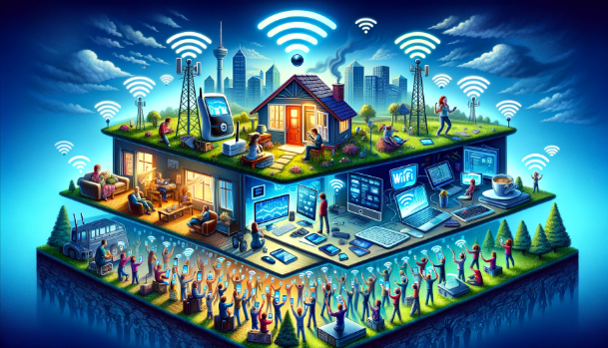|
|
|||||||||||||||||||
|
WiFi in different environmentWiFi is like air these days – it's everywhere! But did you know that where you use WiFi can change how well it works? Just like how it's easier to hear someone in a quiet room than in a noisy one, WiFi can have an easier or tougher time depending on where it is. When we know what challenges each place brings, we can make WiFi that works great, whether you're at home, at work, or anywhere else! We want everyone to have a good connection, so you can do what you need to do online without a hitch.
Some of common deployment (installation) of WiFi / WLAN are listed below.
Home EnvironmentsIn a home setting, WiFi is expected to be simple, seamless, and secure. The primary concerns are coverage and the ability to handle multiple devices. Mesh networking has become popular in homes, as it provides comprehensive coverage and easy setup. However, interference from neighboring networks and household appliances can affect performance. Solutions include selecting the appropriate channel, using WiFi extenders, and ensuring that the network is secure against unauthorized access. Enterprise EnvironmentsEnterprise environments demand high-capacity, reliable, and secure WiFi networks to handle a large number of concurrent users and sensitive data traffic. Advanced features like VLANs, multiple SSIDs, and enterprise-grade security protocols are standard. Network administrators must perform detailed site surveys to plan the network layout and use management tools to monitor and maintain network health. High-Density EnvironmentsLocations such as stadiums, airports, and conference centers, where a large number of users gather, require WiFi networks that can handle high-density situations without degradation in service. Technologies like advanced MU-MIMO, high-density access point placement, and proper channel planning are critical to manage the high traffic and to provide a satisfactory user experience. Outdoor and Rural EnvironmentsDeploying WiFi in outdoor and rural areas poses distinct challenges due to large distances and lack of infrastructure. Long-range wireless technologies and directional antennas are typically used to extend the reach of WiFi networks. Power requirements are also a consideration, often leading to the use of solar or wind power in remote locations. Industrial EnvironmentsWiFi in industrial settings must be robust and reliable, capable of operating in harsh conditions and around interference from heavy machinery. Industrial WiFi often employs ruggedized equipment designed to withstand extreme temperatures, moisture, and dust, along with strong encryption and authentication to protect sensitive data. Healthcare EnvironmentsHospitals and healthcare facilities require uninterrupted WiFi for critical communications and access to patient records. The network must comply with health privacy regulations and be able to support a variety of devices, including medical equipment. Network reliability is crucial, necessitating redundant systems and rigorous testing protocols. Educational EnvironmentsSchools and universities need WiFi to support a digital learning environment. This includes having the capacity to handle numerous devices simultaneously and the flexibility to adapt to various teaching methods and resources. It's also important for these networks to have content filtering and monitoring to ensure a safe and focused learning environment. Retail EnvironmentsRetailers use WiFi for both operations and customer engagement. Operational WiFi supports inventory management and sales operations, while customer-facing networks provide added value for shoppers, such as in-store navigation and personalized offers. Retail WiFi must be secure to protect both the business and its customers.
|
|||||||||||||||||||
